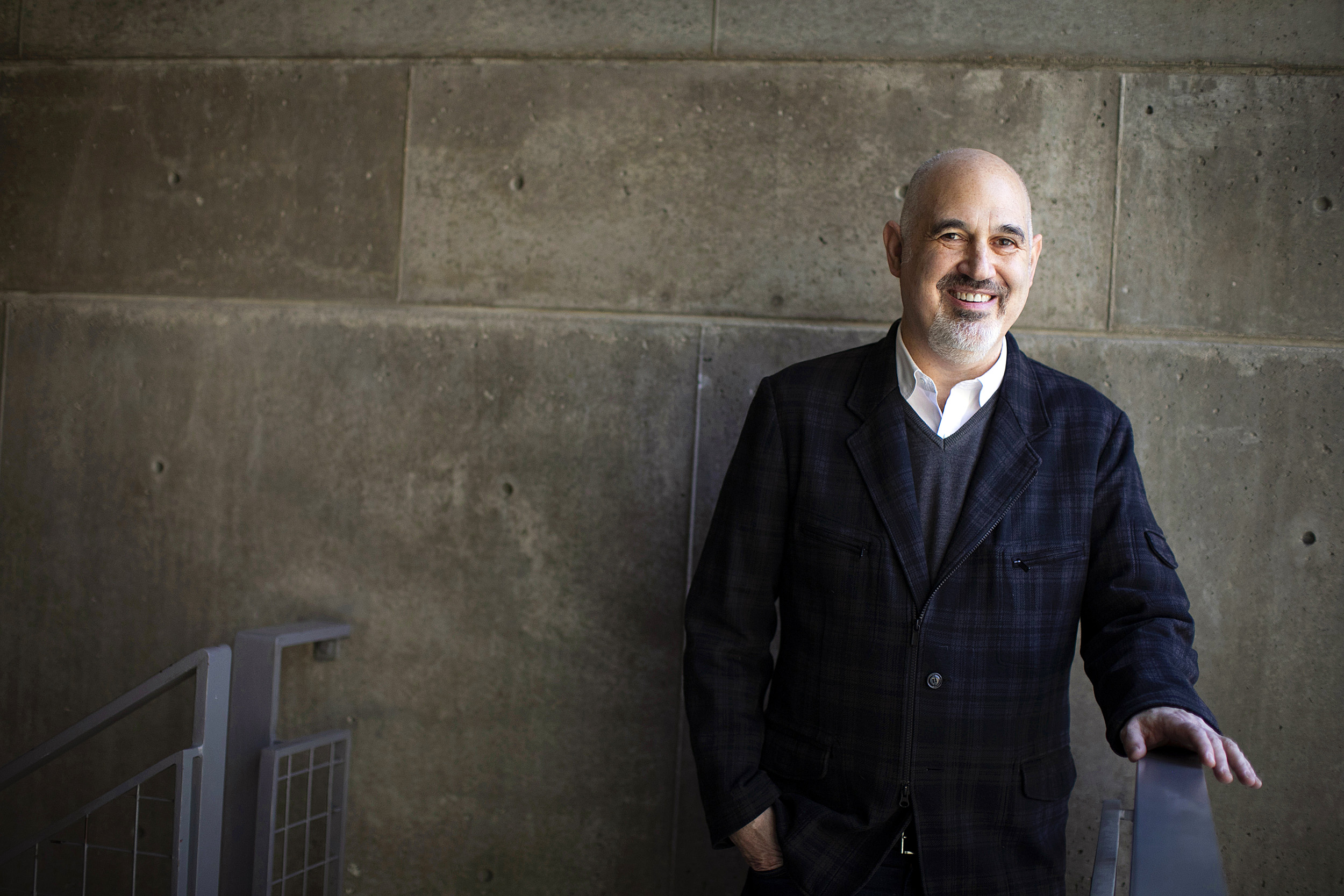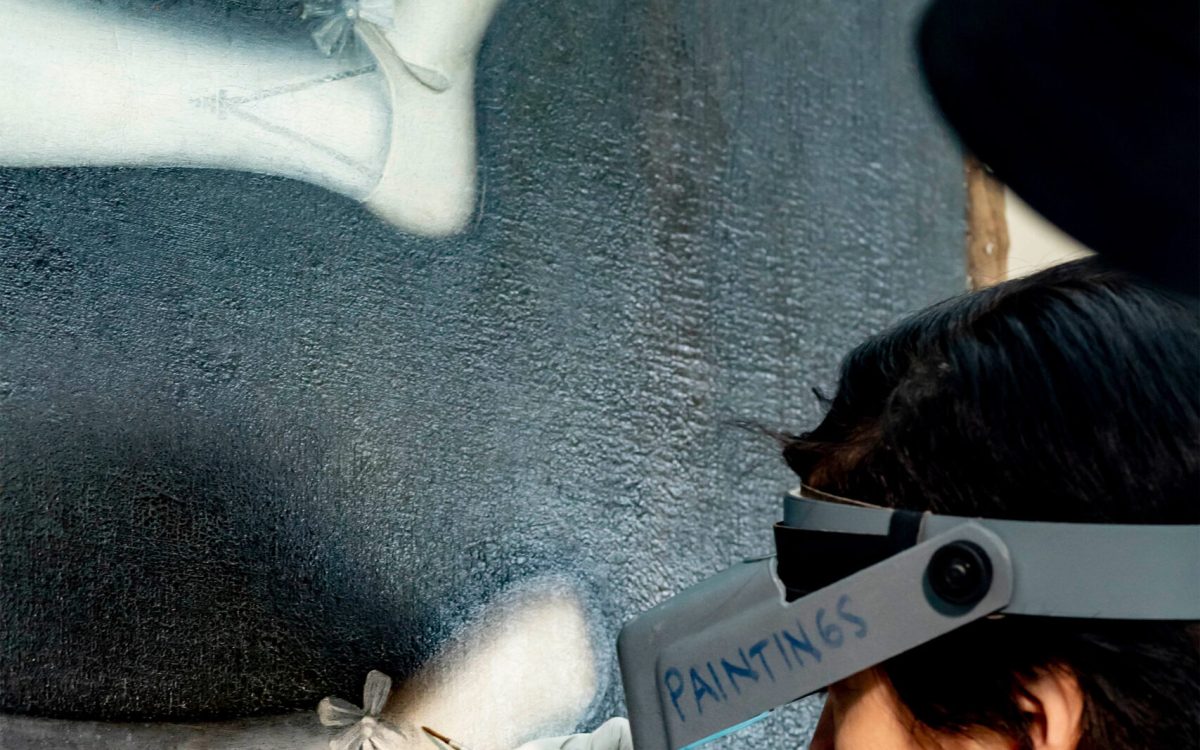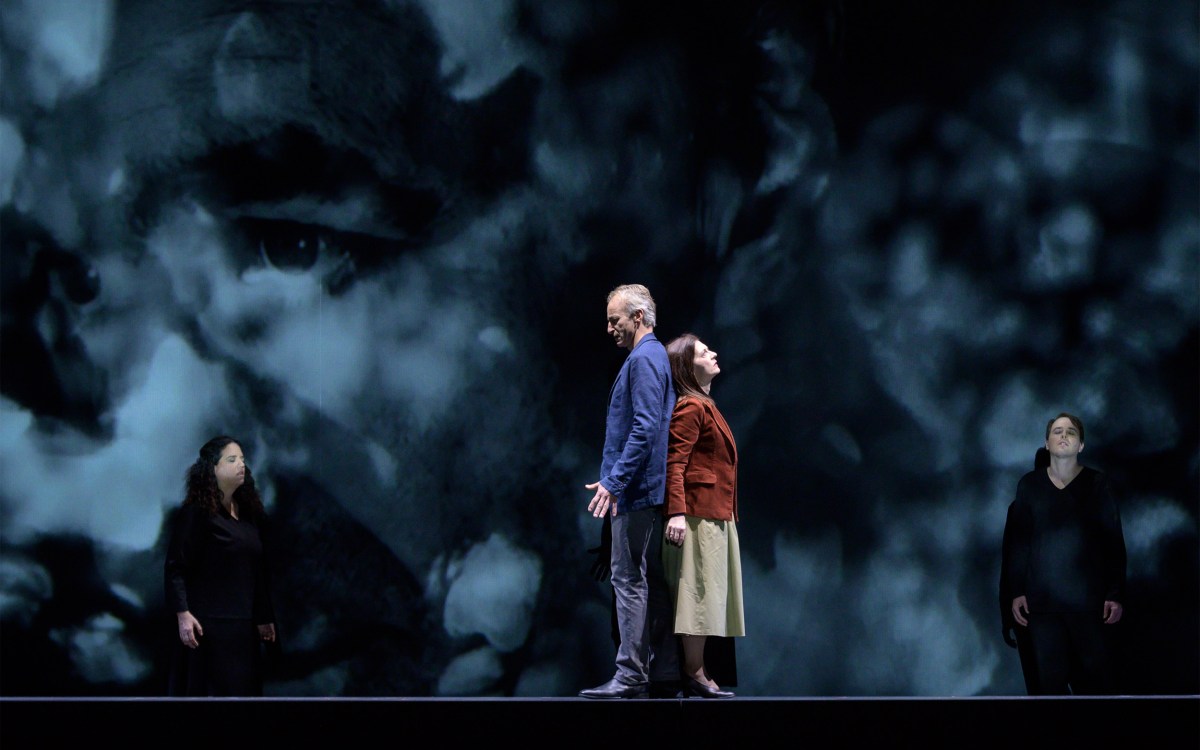
David Joselit explains how he both learns from and teaches contemporary art.
Stephanie Mitchell/Harvard Staff Photographer
New faculty: David Joselit
Interpreting political and cultural change through images
David Joselit sees images as a way to understand and interpret political and cultural change, both in institutions like museums and in more informal ways. He has traveled to museums around the world, including the Museum of Black Civilisations in Dakar, Senegal, and the Louvre Abu Dhabi, to examine the ways in which contemporary international facilities embrace Western traditions while attempting to reimagine the idea of artistic universality in a globalized landscape. Joselit, who earned a bachelor’s degree and Ph.D. from Harvard in art history, joined the department of Art, Film, and Visual Studies this semester as a professor of visual studies.
Q&A
David Joselit
GAZETTE: How does your background as a curator and critic influence your teaching and research?
JOSELIT: I used to be a curator, briefly at the De Cordova Museum and for several years at the Institute of Contemporary Art in Boston before getting my Ph.D. in art history here. I’ve always had an interest in how images create political effects. I’ve tried to bring skills in close reading that one learns as an art historian to archives that aren’t necessarily art historical, such as the structure of broadcast television in the 1950s and ’60s, which I set beside video art and cable TV activism in my 2007 book, “Feedback: Television Against Democracy.” This is one of the reasons why I was particularly drawn to this department, where I feel like my teaching can reflect those interests in a different way. Curators create narratives or knowledge by juxtaposing artworks and other kinds of images, which is a different logic to what an art historian would do. I’ve always had a perspective of a critic and a curator in that I’m very interested in both in the testimony of contemporary artists and ways of reading images through other images. It is really important to me to have a critical practice, which I have had since I was an undergraduate here. I wrote for the Boston Ledger, a small neighborhood newspaper that I was an art critic for and which doesn’t exist anymore. Criticism that is pointed, polemical, and grounded in current situations, which is related to curatorial work at least in the contemporary field, is at the core of how I try to work. Nonetheless, I really believe in a strong historical grounding for contemporary art. I think in order to understand contemporary art, you need to put it into a much longer history than is often done.
GAZETTE: What are you teaching this semester?
JOSELIT: The course is called “Vision and Power: Introduction to Visual Studies.” I am very interested in visual studies as a problem and a field. In this class, which is a graduate-level seminar, I’m trying to give an account of what visual studies might be, using various keywords to think of images and power, and how you define archives and extract specific images from them. There are two main keywords we’re using. One is archaeology, and it has to do with a kind of sedimented form of knowledge, the idea that we read images through images, and that there are all kinds of embedded meanings. You can’t just look at an image or a work of art and decode a meaning lying behind it; significance is generated from underlying discursive forces. This keyword pertains to different readings, such as Michel Foucault’s “Archaeology of Knowledge,” where he approaches knowledge from the perspective not of individual statements, but of the social norms and discursive regularities that make what we say intelligible and “truthful” at any particular historical moment. Then there is the German media archaeology tendency associated with figures like Friedrich A. Kittler, who explores, for example, how different technologies like a typewriter or film create certain kinds of discourses. I’m also talking about how archaeology in different parts of the world, such as the Middle East, is used to create nationalist statements.
The other major keyword in the course is forensics, which comes from a fascinating group called Forensic Architecture in London, which was founded by Eyal Weizman, an Israeli architect and thinker. Forensic architecture recreates events, such as stealth attacks, that are suppressed by governments by collecting visual evidence online and doing diagnostic projects. For example, they reconstruct stories of terrorist attacks or the sinking of a ship in the Mediterranean with migrants on it. But we will move beyond such literal forensics to questions of how various archives such as those of African American history are often very incomplete because African American subjects didn’t leave the kind of documents, especially during slavery, that other Americans might have. It’s about a reconstruction of archives and how archives relate to images.
I have taught many classes on global contemporary art, and it took several times out before I felt I had arrived at a paradigm or argument that made sense. Recently, I was presenting an example in class, and one of the students homed in on a blind spot in my example in a really productive way. That’s what you get from teaching. You get the knowledge of many other smart people working with you to figure something out.
GAZETTE: How has the transition to online teaching been?
JOSELIT: In the seminar I teach, we have grown to know each other, which makes remote teaching easier than it would be in a large lecture class. I have asked members of the class to bring in images they find relevant to each week’s readings, and we’ve dedicated a portion of each session to their presenting them, which has been a good way to keep everyone involved and participating. But I have also been thrilled with how interesting and creative the choice of images has been. We also decided to go ahead with a planned presentation from Diana Carey, a research Librarian at the Schlesinger Library, on a series of 19th and early 20th century photographs of not-yet identified African Americans that the Library has been adding to its collection.
GAZETTE: As an art critic, what do you think about art museums and galleries transitioning to online offerings during this time, and do you think the pandemic will affect the way we interact with museums going forward?
JOSELIT: For some time now, museums have been very conscious of their role as “content providers” beyond their physical facilities, and have been experimenting with various forms of web content. To be honest, I had been skeptical of these efforts, but the pandemic has caused me to change my mind. Last week I watched excellent short presentations about exhibitions at the Metropolitan Museum and MoMA, and I assume that I’m not the only person who is exploring these resources more seriously right now. Though there’s nothing like seeing a work of art in person, it’s not a zero-sum game. Online presentations can draw people in to visit or offer experiences that those who can’t afford to travel or who will not want to travel as much once we are free to leave our homes. I’m more ambivalent about how large commercial galleries have generated online content, which feels much more like self-promotion, but it may lead to even greater changes in how the art world operates. The contemporary art market is now premised on a grueling schedule of art fairs, all of which have been canceled during this period. After the quarantine, galleries may prefer for many reasons — ranging from concern about carbon footprints, to concern about their bottom lines—to begin using the Internet in place of the art fair system.
“That’s what you get from teaching. You get the knowledge of many other smart people working with you to figure something out.”
GAZETTE: Are you working on other projects in addition to teaching?
JOSELIT: My new book came out in March, and is called “Heritage and Debt: Art and Globalization.” I wanted to write about globalization, but using art as my archive. The title comes from the proposition that heritage — specific, inherited cultural practices and values which allegedly have been flattened out through globalization — actually becomes more and more important as there is a kind of flattening of the world.
What I argue is that around 1989, which is a pretty standard watershed moment for globalization, different histories of modern art that developed in relative isolation in different regions of the world come together and begin to be synchronized in contemporary art practices. I see four such genealogies of modernism: Western modernism, postcolonial modernism, socialist realism, and underground modernism. I try to build this plural history of multiple modernisms in order to demonstrate its synchronization in the 1990s. It’s a reading of modern art, but its intention is to explain how different modernisms come together in contemporary art.
I also argue that in various parts of the world where manufacturing economies are giving way to knowledge economies like Singapore, Cape Town, and the Emirates, you find high concentrations of new museums, which signal and symbolize a transition from a manufacturing economy to a knowledge economy. The growth of this cultural infrastructure is intended in part to attract knowledge workers. The arts get involved in a whole set of economic and cultural dimensions, which are part and parcel of globalization.
GAZETTE: You studied art history, but now you are working in a department that has a focus on artistic practice. What is exciting to you about that change?
JOSELIT: I want to learn from my students’ approach, and this is where the curatorial dimension comes in. I’ve always felt that most of my best ideas have come from being in dialogue with artists. I’m hoping I will collaborate with some of the artists and filmmakers in AFVS. Last year, I was a visiting critic at the Institute of Contemporary Art [in Maryland], in the painting school, and it was so fulfilling and inspiring to meet students and to work with them. I’m hoping that I’ll be able to fashion a way of teaching that will include that kind of interaction as well.
GAZETTE: As someone who has spent a lot of time at Harvard over the years, do you have a favorite place on campus?
JOSELIT: When I was here as an undergraduate, I was the editor of a poetry magazine called Padan Aram, and I used to love the Woodberry Poetry Room at the Lamont Library. I am looking forward to going there again.







